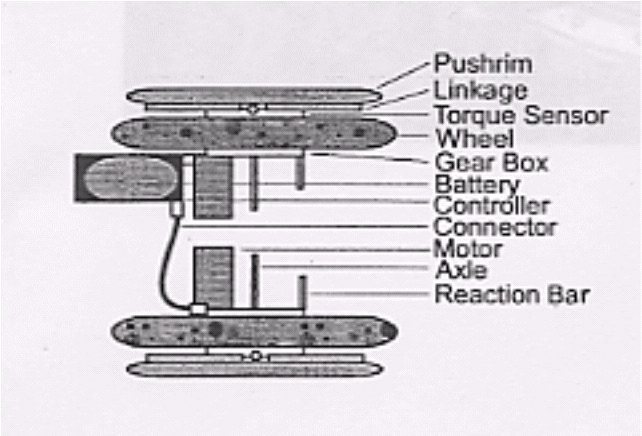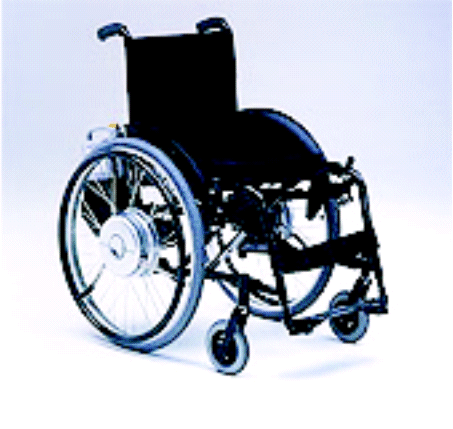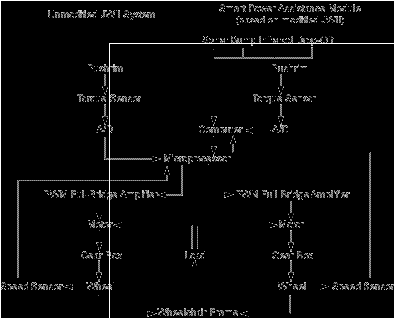Smart Power Assistance Module for Manual Wheelchairs
Abstract
Investigators are developing a system of components that can be attached to manual wheelchairs to convert them into "smart" manual wheelchairs. The system is being designed as a mobility solution for individuals with visual and physical impairments, but is expected to be useful for other user populations as well.
Background
The concept of power assistance for a manual wheelchair is relatively new, and represents a viable alternative for individuals who are unable to generate sufficient propulsion force to use a manual wheelchair, but do not wish to use a traditional powered mobility device [1]. In a power assisted manual wheelchair, the traditional rear wheel hubs are replaced with motorized hubs that serve to magnify or reduce (i.e., brake) the propulsive force applied to the rear wheels by the user. Investigators are using power assistance as the basis for a Smart Power Assistance Module (SPAM) that provides independent mobility to non-ambulatory individuals with visual impairments. The SPAM will use sensors to detect obstacles and drop-offs (e.g., stairs, curbs, potholes) near the wheelchair, and use the motorized hubs to modify the forces applied to each wheel to avoid obstacles.
Statement of the Problem
The target user population for the SPAM consists of individuals with both a visual impairment and a mobility impairment that makes it difficult or impossible to ambulate independently using a white cane, guide dog, or other traditional mobility aid for the visually impaired. The American Federation for the Blind (AFB) has estimated that 9.61% of all individuals who are legally blind also use a wheelchair or scooter, and an additional 5.25% of individuals who have serious difficulties seeing (but are not legally blind) also use a wheelchair or scooter.
Design
The SPAM is based on the Yamaha JWII Power Assist Wheelchair Hubs (shown in Figure 1), which were recently approved by the FDA [1]. The JWII hubs meet the mobility needs of a population of users that (1) need a mobility aid, (2) lack the upper-body strength or function to propel a manual wheelchair, and (3) do not want a powered mobility device.
 |

|
 |
The right side of Figure 2 shows the design of the SPAM. The SPAM will be able to sense (1) the propulsive force applied to each rear wheel of the wheelchair, (2) the magnitude and velocity of rotation of each rear wheel, and (3) the location of obstacles and drop-offs relative to the wheelchair. Information from all sensors will be collected by a computer which will: (1) run the system's control software, (2) integrate information about the user's input and the surrounding environment, and (3) pass command signals to the JWII system's microprocessor.
Several types of sensors will be integrated into the SPAM prototype. These sensors will be used for (1) tracking the state of the wheelchair (e.g., wheel velocity, torque applied to each rear wheel by the user) and (2) locating obstacles and drop-offs in the wheelchair's environment. The JWII hubs already contain sensors for measuring the propulsion force applied by the user to each wheel (potentiometers) along with sensors for measuring rotation of the rear wheels (Hall Effect Sensors).
Obstacles are identified using sonar and infrared range finders. The sonar sensors (Sonaswitch Mini-A, EDP Company, Livonia, MI) have a maximum range of 2.4 m (7.9 ft) and a minimum range of 21.8 cm(8.6 in). The advantages of a smaller range are that (1) the frequency of sonar readings is increased and (2) the sonar system will be able to see obstacles that are extremely close to the wheelchair, which is important for passing through doorways. Infrared range finders provide a focused, highly modulated infrared beam, providing absolute ranging based on simple triangulation. The result is an accurate range value between 1.7 and 0.1 meters in a variety of circumstances for the Sharp GP2Y0A02YK (Sharp Electronics, Mahwah, NJ). Bump sensors serve as the ``sensors of last resort'' for the SPAM. When a bump sensor is activated it will bring the chair to an immediate halt. Bump sensing is implemented using contact switches placed on the leading edges of the wheelchair.
The SPAM control software will provide smooth travel while modifying the direction and speed of travel of the wheelchair to avoid obstacles. The control software will combine the existing JWII control software with obstacle avoidance software designed for smart power wheelchairs [2]. Changes in the wheelchair's direction will be accomplished by causing one rear wheel to spin slower than the other, either by accelerating the opposite wheel or through the use of the JWII's regenerative braking capability. Table 1 lists some of the parameters of the control software that will be used to determine the behavior of the SPAM.
Significant attention will be paid to developing a user override mechanism that allows the user to quickly and easily disengage the SPAM's obstacle avoidance in an emergency, but is not so ``quick and easy'' that the override mechanism can be engaged inadvertently. Furthermore, the behavior of the system (both the SPAM components and the Yamaha JWII hubs) once the SPAM is disengaged will be explored to identify how to maintain the user's safety.
Development
At present, the investigative team has identified the sonar and infrared sensors that will be used on the SPAM for obstacle detection, and is conducting experiments to characterize the behavior of the JWII system. Various approaches are being considered for providing navigation assistance to the user. Additional development will include examining solutions for drop-off detection, identifying an appropriate microprocessor, and developing mounting solutions for attaching the components of the SPAM to a range of manual wheelchair frames. Finally, we plan to conduct testing under controlled laboratory settings and out in the field.
Discussion
The SPAM is intended to be an ``after-market addition'' to Yamaha's JWII hubs, which will take advantage of recent efforts which changed the connection between the hubs and the processor unit from a hardwired connection to a plug-and-jack connection. In addition to serving the needs of the visually-impaired, the SPAM is also expected to be useful as an intelligent one-arm drive mechanism for hemiplegics.
References
- R. Cooper, S. Fitzgerald, M. Boninger, K. Prins, A. Rentschler, J. Arva and T. O'Connor (2001). Evaluation of a Pushrim Activated Power Assisted Wheelchair. Archives of Physical Medicine and Rehabilitation, 82(5): 702-708.
- R. Simpson, D. Poirot and F. Baxter (2002). The Hephaestus Smart Wheelchair System. IEEE Transactions on Neural Systems and Rehabilitation Engineering, 10(2): 118-122.
Acknowledgments
This research is funded by a Phase I Small Business Innovation Research grant from the National Eye Institute (#1R43EY014490-01).
Richard Simpson
Department of Rehabilitation Science and Technology
University of Pittsburgh; Forbes Tower,
Suite 5044; Pittsburgh, PA 15260
ris20@pitt.edu
